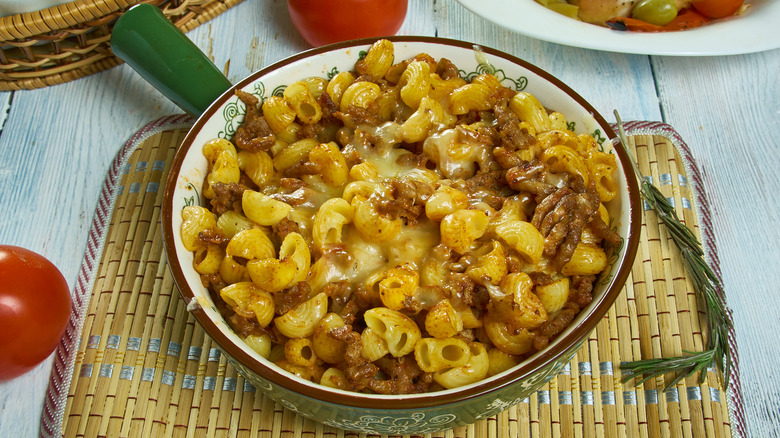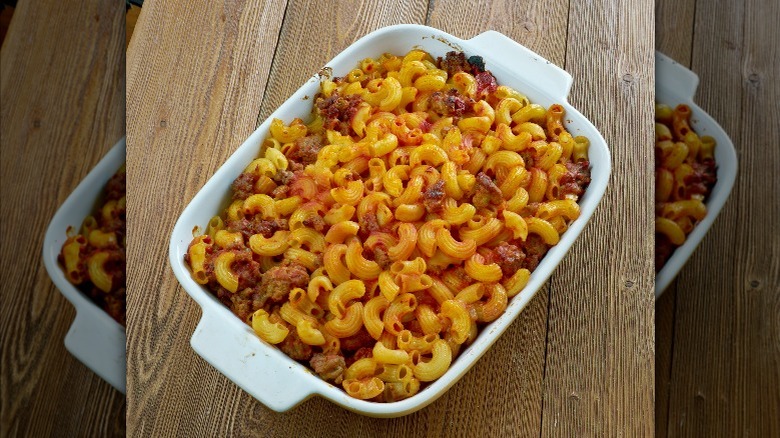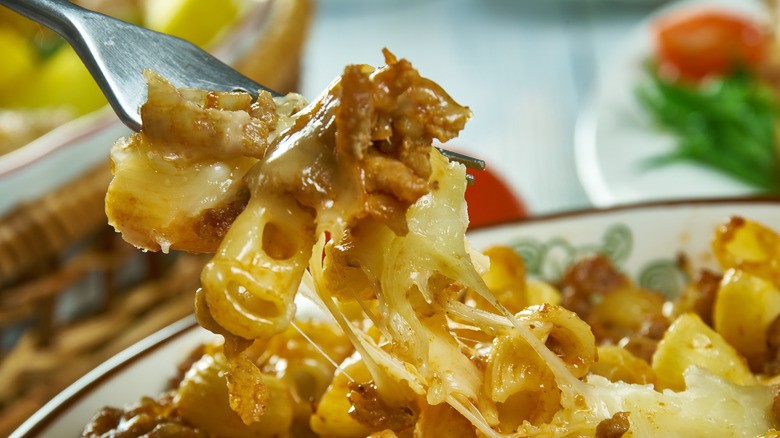How Did The Ohio Pasta Dish Johnny Marzetti Get Its Name?
If you're not from Ohio, especially the Columbus area, you're probably wondering what Johnny Marzetti is. To put it succinctly, it's ground beef, cheese, pasta, and tomatoes baked into a casserole.
Moreover, as Eric Lyttle noted while writing for Columbus Monthly, "If you're from Wisconsin or Minnesota or the like, you might know it as goulash. If you're from northern New England, you likely remember it as American Chop Suey," one of those things only people from the Northeastern U.S. say. Yet, all three dishes contain essentially the same ingredients and are prepared in much the same way, so why the difference in monikers?
Well, that's likely because the legend associated with the name "Johnny Marzetti" may be more apocryphal than many Ohioans realize, leading to citizens of other states giving this dish new regional titles. As the Buckeye State's story goes, Teresa Marzetti — an Italian immigrant who migrated from Florence to Columbus in 1896 – is credited as the first person to serve the casserole at a restaurant, and she named the dish after her brother-in-law. Nevertheless, there's a lot more to the narrative than just that.
The tale of the Marzetti Family
Once Teresa Marzetti and her husband, Joseph, settled in Columbus, they opened an Italian eatery near The Ohio State University, and that restaurant became popular among students there. Although the establishment closed its doors in 1942, other locations remained open — until 1972 at the latest, when Teresa died. However, her family opened a factory where they manufactured their beloved salad dressing back in 1947, and Teresa's legacy lives on through the T. Marzetti Co., which started mass-producing its dressings and selling them in grocery stores statewide by 1955. That business is still going strong today.
Yet, it's uncertain when those restaurants first started making Johnny Marzetti. Still, the dish had garnered quite a reputation in the state and surrounding region by the 1920s, or at least, that's how the story goes. According to the T. Marzetti Co. (via the Chicago Tribune), Johnny Marzetti the dish was never actually on the menu itself. Additionally, the business can't guarantee that Teresa developed the dish or whether the actual Johnny even enjoyed it.
Moreover, as the company's senior consumer services manager, Stefanie Coffman, told Columbus Monthly, "We don't have any documentation that would connect Johnny Marzetti, the dish, to the T. Marzetti Co."
And as the director of business development, Rob Felty, said of the presumed connection, "It was just all made up." So, where did the name really come from?
The best possible explanation for the name
There is one probable, though underwhelming, explanation for Johnny Marzetti's moniker. During research for Columbus Monthly, Eric Lyttle found a recipe from 1916 within The Columbus Dispatch bearing the name. However, the ingredient list called for pork rather than beef and included other components not found in what's commonly considered the norm, such as onions, cayenne pepper, and chili powder.
Even so, the name didn't appear again within the periodical until 1953. It emerged again in 1956 and then 1963, when the publication tried to get to the bottom of things. As the food editor of The Columbus Dispatch, Mary Pegg, concluded several decades ago: Not only is there no connection between this dish and the famed Marzetti family, but the name only really refers to the meal's two main components — noodles and ground beef (or pork, at one point in time, evidently).
This concurs with the assessment of Monica Kass Rogers at The Chicago Tribune. Rogers claims that Columbus' cultural identity is so ingrained in the name that "'making a Marzetti' has become synonymous ... with making a casserole." As a result, there's no concrete answer to the name's origin other than, perhaps, it's just a regional term that somehow gained traction. So, as long as the baked casserole you're cooking in the oven has meat, pasta, tomatoes, and cheese, it's arguably a Johnny Marzetti because, well, that's just what they call it in Ohio.


